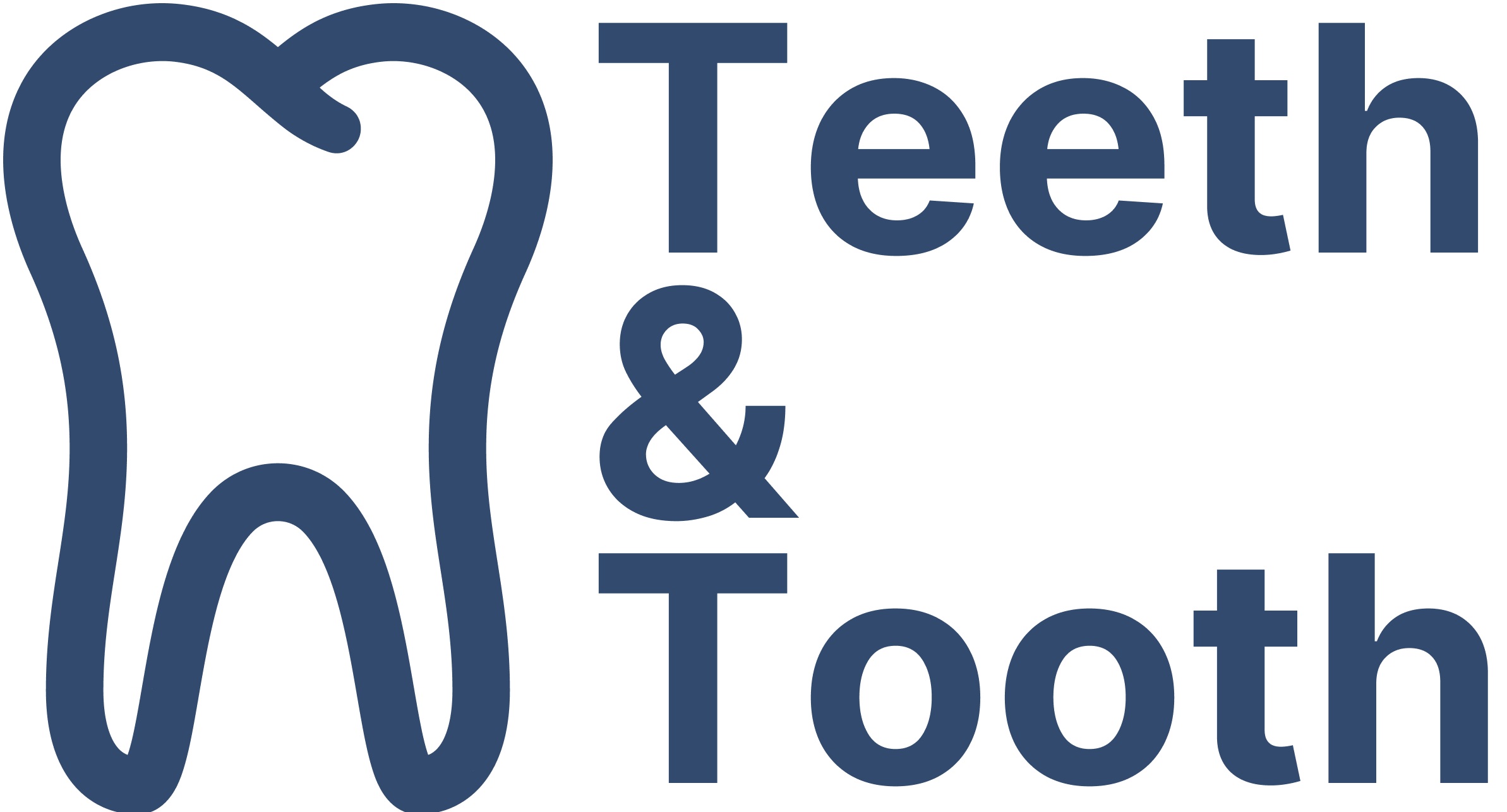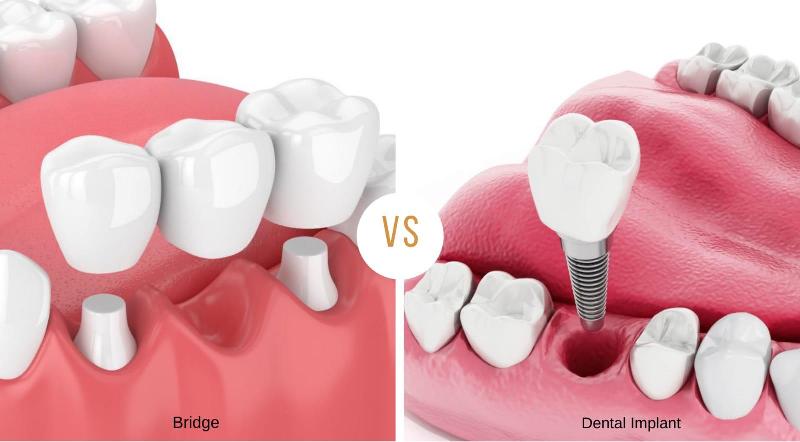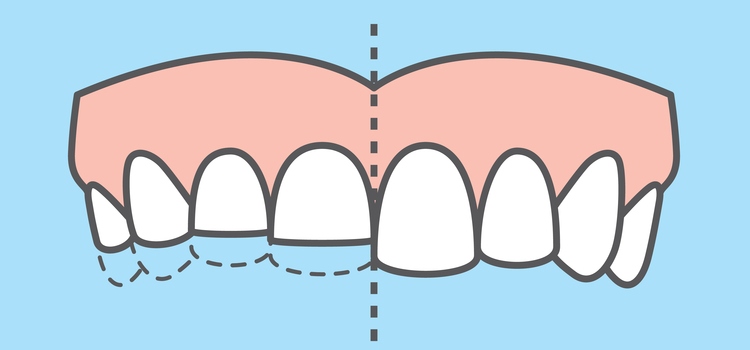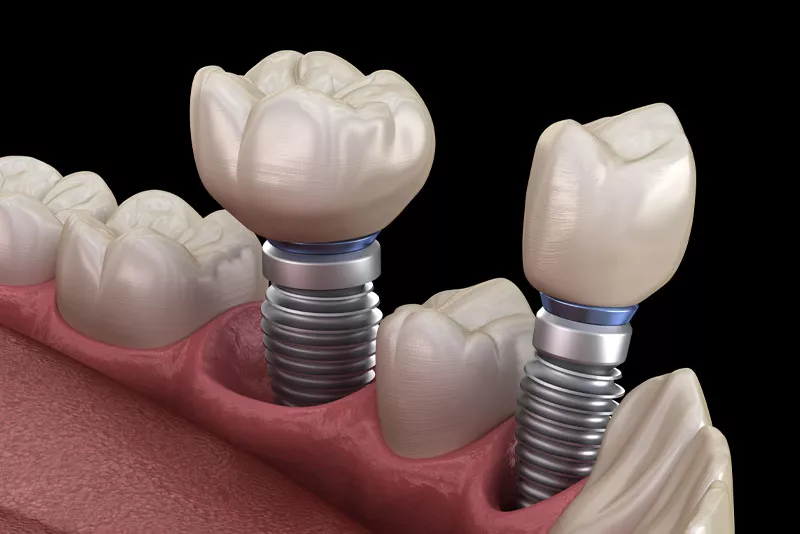Today, there are numerous options when it comes to replacing your missing teeth. Each option has its own set of benefits and limitations, catering to people with different budget and preferences. Among the most popular solutions are dental bridges and dental implants, both of which restores the aesthetic appeal of your smile as well as the functionality of your bite.
While they aim to achieve the same goal, they differ significantly in their treatment approach, longevity of the solution, and its impact on your teeth and jaws. So what are the difference, and which should you choose?
In the rest of this article, we will take a deep dive into dental bridge and implants, and understand the similarities and differences between both treatments. From complexity of the treatment to long-term care, we examine the various facets to consider when choosing between a bridge and an implant. So read on to find out which is the best for you!
What Is a Dental Bridge?
A dental bridge is a fixed dental prosthesis that is designed to replace one or more missing teeth. This is done by anchoring an artificial tooth or teeth to the adjacent natural teeth, essentially ‘bridging’ the gap created by the absence of a tooth.
This fixture is permanently cemented in place, making it a long-term but not necessarily lifetime solution for tooth replacement.
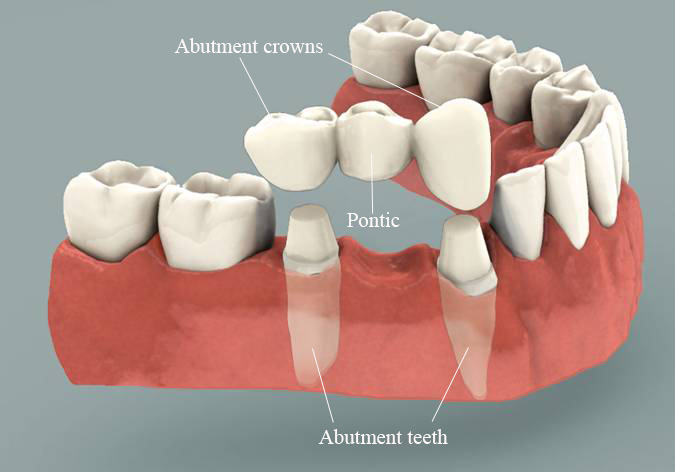
A dental bridge consist of several key component, each crucial to making the prosthetic work. The first is the pontic, which is essentially the artificial tooth that replaces the missing tooth. The pontic is usually porcelain to mimic the natural color of the teeth, although metal or composite resin is also used.
The second component is the abutment teeth, which are the teeth at the sides that serve as an anchor for the bridge. These abutment teeth are prepared by shaping them so that they can be fitted with crowns to hold the bridge in place.
Last but not least, there’s the dental crown. The crown is the cap that is placed over the abutment teeth, providing the stability needed to hold the pontic in place. They are usually made from the same material as the pontic for a uniform appearance.
There are four main types of bridge, each with a specific use case:
- Traditional Bridges: These are the most common type, involving a pontic flanked by two dental crowns that are cemented onto the abutment teeth.
- Cantilever Bridges: This type is used when there are adjacent teeth on only one side of the missing tooth or teeth. A crown is anchored to one single abutment tooth, which supports the pontic.
- Maryland Bridges: Also known as a resin-bonded bridge, this type uses a framework of either metal or porcelain that is bonded onto the backs of the abutment teeth. This is less invasive as it often does not require filing down the adjacent teeth.
- Implant-Supported Bridges: These bridges are supported by dental implants rather than natural teeth. An implant is placed for every missing tooth, and these implants support the bridge.
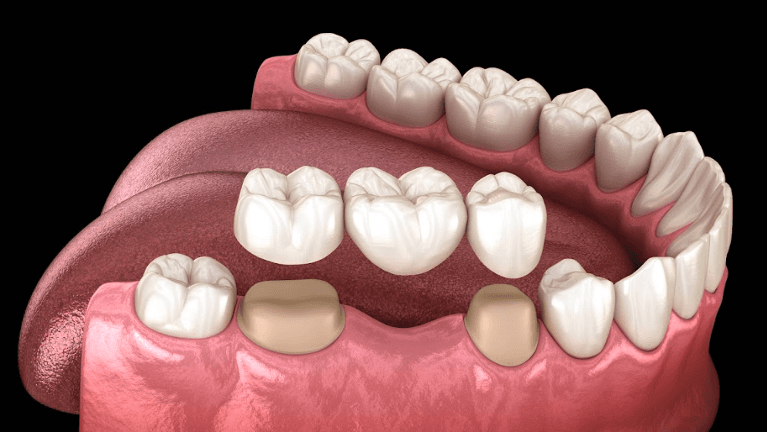
What Is a Dental Implant?
A dental implant is a titanium post that serves as the an artificial root. The implant is surgically inserted into the jawbone, providing a sturdy and permanent base for the mounting of a replacement tooth.
An implant also consist of three component: implant fixture, abutment, and crown. The fixture is the titanium post that is implanted into the jawbone. Its role is to function as an artificial root, anchoring the replacement tooth or teeth.
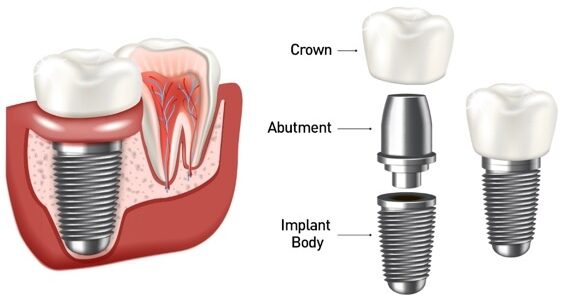
The abutment is a connector that sits atop the implant fixture and holds the replacement tooth. It serves as an interface between the implanted post and the artificial tooth or teeth.
Lastly, the crown is the prosthetic tooth that sits above the abutment. It is typically made of ceramic or porcelain to mimic the appearance of natural teeth.
There are two main types of dental implants:
- Endosteal Implants: These are the most commonly used type and are inserted directly into the jawbone. After the surrounding gum tissue has healed, a second surgery is needed to connect an abutment to the original implant, followed by attaching the artificial tooth or teeth.
- Subperiosteal Implants: These consist of a metal frame that is fitted onto the jawbone just below the gum tissue. As the gums heal, the frame becomes fixed to the jawbone. Posts are then attached to this frame, protruding through the gums, and act as an anchor for the artificial teeth.
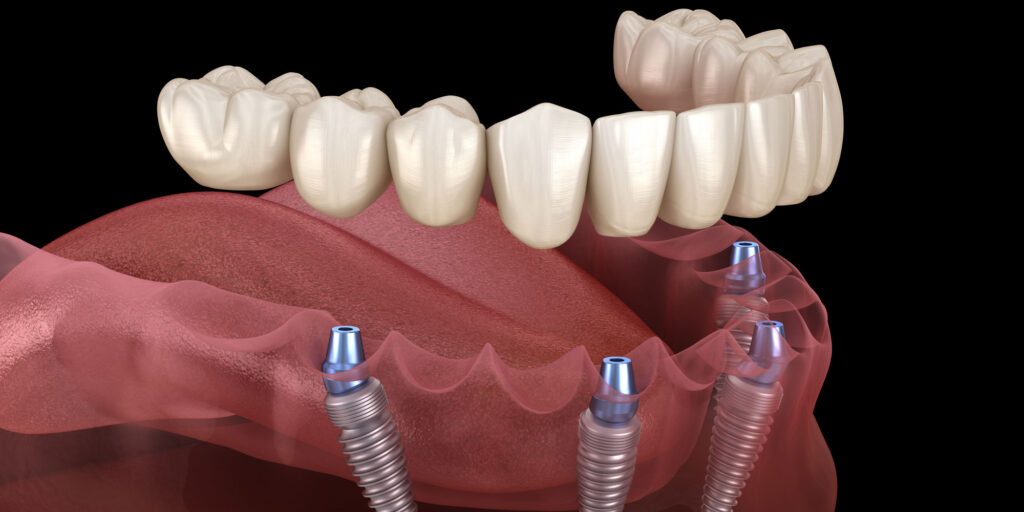
What Are the Similarities and Differences?
As mentioned above, both dental bridge and implants serve to replace a missing tooth, and aim to restore both the functionality and aesthetic appeal of your smile. There are several notable similarities between the two:
- Permanent Solution: Both bridges and implants are fixed, meaning they can’t be removed for regular cleaning like removable dentures. This offers the advantage of a more natural feeling in the mouth.
- Tailored to Individual Needs: Both dental bridges and implants are custom-made to fit the individual’s mouth and match the neighboring teeth, ensuring a natural look and feel.
- Natural Appearance: Modern dental technology allows both bridges and implants to be made from materials that look and feel like natural teeth. Porcelain and ceramic are the two most commonly used material to mimic the texture and color of actual teeth.
- Regular Hygiene and Maintenance: Both require a robust dental care regimen to ensure longevity. Bridges require meticulous cleaning under the bridge, while implants require good gum care to prevent peri-implantitis (gum disease around the implant).
You may be interested in: The 10 Truth About Dental Implants That You Need to Know
However, there are also significant differences between the two in terms of structure, procedure, longevity, and impact on surrounding teeth and bone. Here’s a breakdown of the differences:
- Foundation: Dental implants involve a titanium post implanted directly into the jawbone, acting as an artificial tooth root. Bridges, on the other hand, rely on existing natural teeth on either side of the gap to serve as anchors.
- Surgical Procedure: Dental implants require surgical intervention to place the implant into the jawbone, whereas dental bridges usually do not require surgery but involve reshaping the anchor teeth. In some cases where there’s insufficient bone density, bone grafting is necessary for implants.
- Timeline: Implants require a longer treatment time due to the need for osseointegration (the implant fusing with the bone). This can take months to complete. In contrast, dental bridges can usually be completed in a couple of weeks.
- Longevity: Dental implants can last a lifetime if properly cared for. Bridges generally have a shorter lifespan, typically 10 to 15 years, and may need replacement or repair.
- Impact to Adjacent Teeth: Implants are more resistant to wear and tear because they are standalone structures. Bridges put additional stress on the anchor teeth, which may lead to long-term damage.
- Tooth Preservation: Dental implants do not require alteration of the adjacent teeth, preserving their integrity. Bridges require the adjacent teeth to be filed down to accommodate the crowns.
- Cost: Dental implants are much are more expensive due to the long timeline and need for surgical intervention. However, their longevity may make them cost-effective in the long run against dental bridges.
- Insurance Coverage: Dental insurance may cover bridges more frequently than implants, although this varies by plan.
Understanding these differences can help individuals make an informed decision about which tooth replacement option is best for their specific needs.
Which Is the Best?
You may now wonder which solution is the best. The answer is that it depends. Determining whether a dental implant or bridge is “best” depends on several individual factors, including oral health, financial considerations, and personal preferences.
1. Dental Health
The first point of consideration is the current state of your dental health. Specifically, the condition of the surrounding teeth and the density of the jawbone are critical factors. Dental bridges rely on adjacent teeth for support, meaning these teeth must be strong and healthy. On the other hand, implants require a sufficient amount of jawbone for successful installation. In cases of low bone density, additional procedures like bone grafting may be required, complicating the process.
2. Timeframe
Dental implants involve surgical procedures and a longer healing time, making them more invasive but often more durable. Dental bridges, however, are generally less invasive and can often be completed in a much shorter timeframe. This could be advantageous for those looking for quicker solutions or those who are not good candidates for surgical procedures.
3. Budget
Cost is often a significant factor in making a dental decision. Implants are usually more expensive upfront but can be more cost-effective in the long run due to their durability and lower maintenance. Dental bridges are often less expensive initially but may incur future costs for maintenance or replacement. Insurance coverage is another factor; dental bridge are covered extensively in most insurance as compared to dental implants.
4. Longevity
Dental implants, when properly cared for, can last a lifetime, making them a long-term solution. Bridges, while effective, usually have a shorter lifespan of around 10 to 15 years and might require replacement or maintenance during that time.
5. Look and Feel
Both solution seek to provide a natural look and feel. However, many prefer dental implants as they resemble a real tooth emerging from the gum. Bridges can offer a natural appearance but might not feel as natural as implants. The level of comfort can differ between the two, with some people finding implants more comfortable in the long term because they function more like natural teeth.
6. Overall Health
Finally, your overall health conditions could play a pivotal role in your decision. If you have preexisting medical conditions like diabetes or heart disease, this could impact your ability to heal from a surgical procedure, potentially making a dental bridge a more suitable choice.
As seen, the choice between a dental implant and a bridge is a multifaceted decision that depends on various factors, including dental health, procedure type, cost, longevity, aesthetics, lifestyle, and overall health. If you have any concerns, do discuss this with your dentist. They will be able to provide a comprehensive evaluation and help you make an informed decision tailored to your needs.
You may be interested in: Can a Wisdom Teeth Fall Out Naturally On Its Own?
Closing Thoughts
Understanding the options available is crucial. Dental bridges and implants each offer unique advantages and come with their own sets of considerations.
Dental bridges offer quicker results and are generally less invasive, making them suitable for those looking for a fast solution and those who might not be ideal candidates for surgery. Implants, on the other hand, offer a more permanent and natural-feeling outcome but come with a higher upfront cost and a longer procedure timeline.
However, neither option can be declared as the ‘best’ as it depends on your unique dental needs, financial situation, and long-term expectations. We hope that you are now armed with the knowledge to have a more informed discussion with your dentist.
